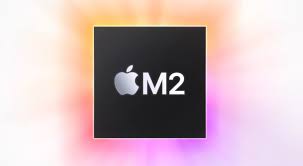Apple M2
The Apple M2 is the second generation of Apple's custom-designed system on a chip (SoC) for Mac computers. It was announced at WWDC 2022 on June 6, 2022, and is based on TSMC's N5P process. The M2 has 20 billion transistors, up from 16 billion in the M1, and features an updated 8-core CPU with two performance cores and four efficiency cores, as well as a 10-core GPU (up from 8 cores on the M1). The M2 also has a new Neural Engine with 16 cores, up from 12 on the M1.
The M2 offers significant performance improvements over the M1. In Geekbench 5, the M2 scored 1,919 points in single-core performance and 8,947 points in multi-core performance, compared to 1,709 points and 7,433 points for the M1, respectively. The M2 also offers better graphics performance, with the 10-core GPU scoring 30,426 points in Geekbench 5's OpenCL benchmark, compared to 20,496 points for the 8-core GPU on the M1.
In addition to performance improvements, the M2 also offers some new features. For example, it supports ProRes encoding and decoding up to 8K resolution, and it can also be used to power up to two external displays at up to 6K resolution. The M2 also supports up to 24GB of unified memory, up from 16GB on the M1.
The M2 is currently available in the new MacBook Air and the 13-inch MacBook Pro. It is expected to be used in other Mac computers in the future.
Here is a table comparing the Apple M2 to the Apple M1:
Feature Apple M2 Apple M1
CPU 8-core (2 performance, 4 efficiency) 8-core (4 performance, 4 efficiency)
GPU 10-core 8-core
Neural Engine 16-core 12-core
Memory Up to 24GB Up to 16GB
ProRes encoding and decoding Up to 8K resolution Up to 4K resolution
External display support Up to two displays at 6K resolution Up to one display at 6K resolution
The M2 is manufactured using TSMC's N5P process, which is a second-generation 5nm process. This process allows Apple to pack more transistors into the M2, which results in better performance and power efficiency.
The M2 has a 10-core GPU, which is up from 8 cores on the M1. This gives the M2 a significant advantage in graphics-intensive tasks, such as gaming, video editing, and 3D rendering.
The M2 has a 16-core Neural Engine, which is up from 12 cores on the M1. This allows the M2 to perform machine learning tasks faster and more efficiently.
The M2 supports up to 24GB of unified memory, which is up from 16GB on the M1. This gives the M2 more memory bandwidth, which can improve performance in some tasks.
The M2 supports ProRes encoding and decoding up to 8K resolution. This makes it a good choice for creative professionals who need to work with high-resolution video.
The M2 can be used to power up to two external displays at up to 6K resolution. This gives users more flexibility in how they use their Mac computer.
Overall, the Apple M2 is a powerful and versatile chip that offers significant improvements over the Apple M1. It is a good choice for anyone who is looking for a fast and capable Mac computer.
